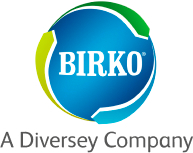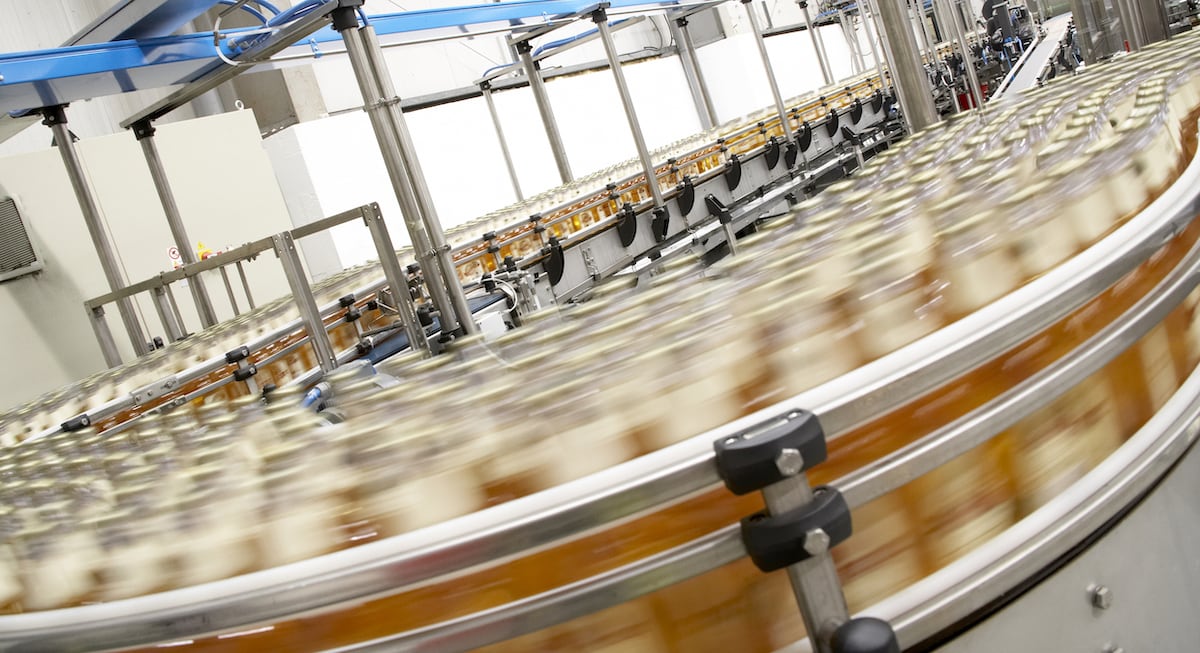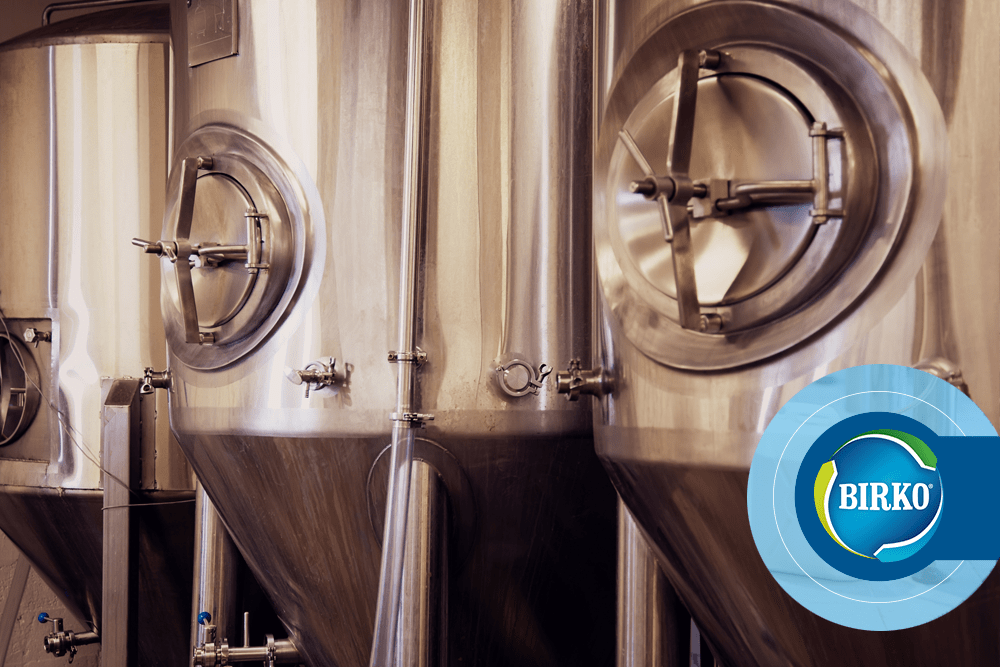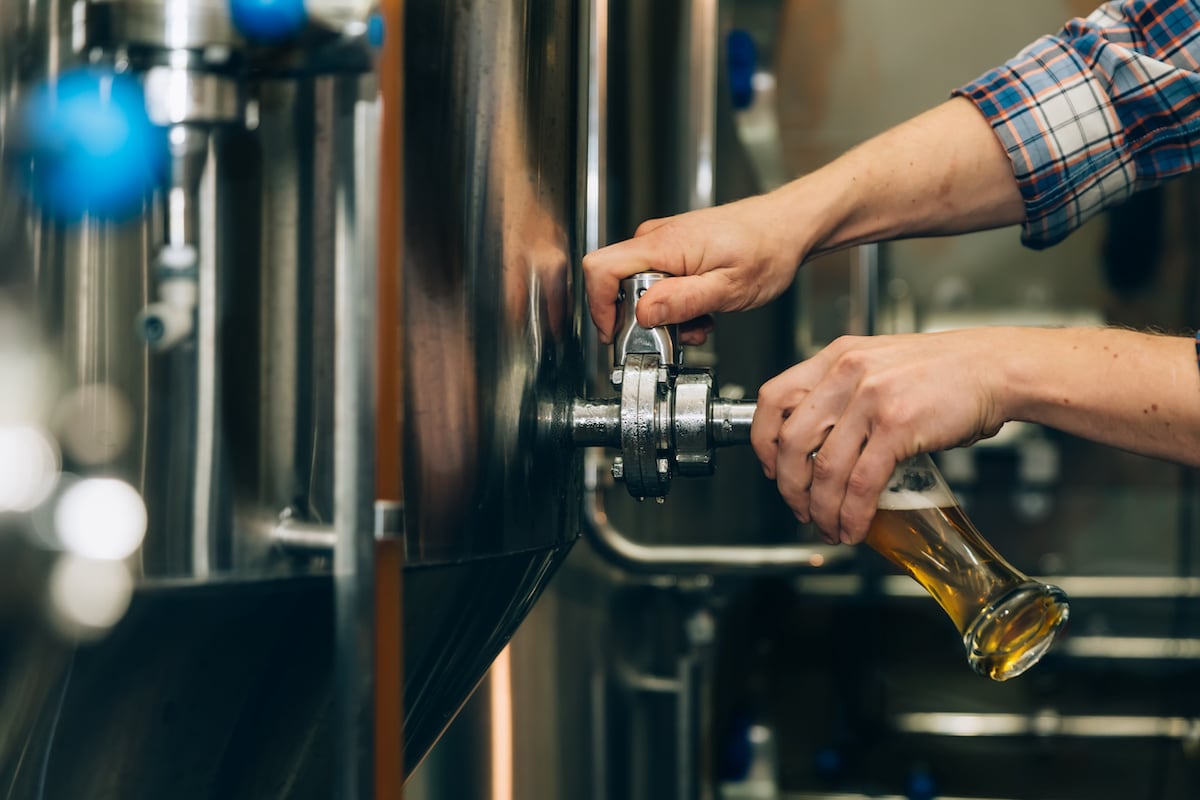Brewers frequently struggle with the best way to ensure microbial free equipment. We’ve found that post-rinse sanitizing is one of the most effective means of accomplishing this while saving rinsing steps at the same time. A traditional procedure for cleaning and sanitizing utilizes the following steps: 1. Rinse with warm water to remove as much of the organic soil as possible. 2. Cleaning with hot water and an alkaline-based cleaner to remove protein by hydrolysis, emulsification and/or saponification. 3. Rinse with phosphoric acid to neutralize the caustic and remove beerstone (calcium oxalate). If the acid also contains nitric acid, a passivation (coating) effect occurs on stainless steel. 4. Rinse with cold water. 5. Post-rinse sanitize.
The post-rinse sanitizer of choice for many brewers is iodophor, which are iodine based and extremely effective at destroying beer contaminating organisms such as lactobacillus, mold, pediococcus and wild yeast at 12.5-25 active parts per million (ppm) of titratable iodine. However, a problem can occur with iodophor if the amount used is not accurately measured. For a 1.75% titratable iodine concentrate, no more than 1 (one) fluid ounce per 5 gallons of water should be used to achieve 25 ppm active. Overusing iodophor serves only to flavor beer and does not offer any additional microbiocidal effect.
While the majority of brewers do not over use iodophor, occasionally it is noticeable in finished beer. The taste associated with beer that has been flavored with iodophor can be termed medicinal or phenolic, (sort of like a bandaid), metallic or “tinny”. The author’s tastebuds seem to be very sensitive to this particular flavor characteristic in beer.
A post-rinse sanitizer which is not iodine based has started gaining acceptance with craft brewers. Chlorine dioxide (ClO2), like iodophor, is very effective at destroying spore forming organisms at low active parts per million (ppm) levels and does not flavor beer when used properly. Unlike iodophor, however, the amount used is typically not as critical both in terms of microbial reduction and flavoring beer. In other words, you will still get an effective kill at an active level of 50-100 ppm ClO2 while maintaining a minimal or non-existent flavor profile.
Remember: Sodium Chlorite is not Sodium Hypochlorite!
Mention the words “chlorine” and “sanitizing” in the same breath around most brewers and their response is, normally, “It will flavor my beer.” (This usually comes from the same person who taints his / her brew with iodophor). In the case of sodium hypochlorite bleach, they are correct. As little as 1-2 ppm active hypochlorite is detectable in drinking water. Triple rinsing is necessary to remove bleach from brewing equipment and bottles so as not to flavor the beer with chlorine. Therefore, post-rinse sanitizing equipment and bottles is not recommended with hypochlorite bleach.
Conversely, chlorine dioxide is ideal for sanitizing after the cleaner has been rinsed. Chlorine dioxide removes phenolic tastes and odors from water and does not form trihalomethanes or chlorophenols. (1) This is very important to the brewer because these compounds are extremely detrimental to beer, not to mention the toxicity to humans or the environment. Chlorine dioxide is also used to remove cyanides, sulfides, aldehydes and mercaptans from water. These compounds are unfavorable for beer, too. That’s great, you say, but what is chlorine dioxide?
Homebrewers are familiar with sodium hypochlorite (NaOCl), 5.25%. The best known brand is Clorox. In his book, The Complete Joy of Homebrewing, Charlie Papazian recommends using 2 ounces of bleach per 5 gallons of water to clean and sanitize fermenters and bottles. 5.25% Sodium Hypochlorite is cheap, usually costing around one dollar per gallon at your local supermarket. The principal mechanism which kills the organisms in a 200 ppm solution of hypochlorite bleach is the action of hypochlorous acid, (HOCl). Chlorine dioxide relies on oxygen chemistry (oxidation) to kill organisms. Both mechanisms are extremely quick, but leave little residual protection. In other words, if the soil is not adequately removed in the cleaning process or should recontamination occur, either sanitizer does not continue to offer protection.
Chlorine dioxide sanitizers are shipped from the manufacturer as sodium chlorite, (NaClO2), solution. United States Department of Transportation (DOT) regulations require that sodium chlorite solutions containing greater than 5% NaClO2 carry a corrosive label. These solutions are basic in pH (8.0-8.5 @ 1%) and the end user must normally “activate” the solutions to generate the chlorine dioxide gas.
For brewers, activation of the sodium chlorite solution with food grade acid is recommended to generate the chlorine dioxide. In one method of activation, citric, lactic, or phosphoric acid is added to drop the pH of the water to between pH 4.5-5. The sodium chlorite is then added to the acidified water to generate chlorine dioxide. This method works well for small volumes of water or with soft water. If the water contains high alkalinity or if the volume of solution is large (i.e. more than a barrel), the concentrate can be activated in a small volume with acid, then the activated solution added to the remaining water. Once the chlorine dioxide gas is generated, it is effective over a wide pH range. (Microbial reduction is unaffected by pH 6-10 once the chlorine dioxide is generated).(1)
The acidification of sodium chlorite, NaClO2 at moderate acid pH (5 – 6) to generate chlorine dioxide gas, ClO2, has a mechanism as follows(2):
5NaClO2 + 4H+ —-> 4ClO2 + 4Na+ + Na+Cl- + 2H2O
Five molecules of the sodium chlorite use four molecules of acid to make four molecules of the chlorine dioxide gas and some leftover salt and water.
At more aggressive pH (4.5 or less), chlorite becomes chlorine dioxide on a more one-to-one basis involving several mechanisms. The chlorine dioxide then exists as a soluble gas in the water.
If the sanitizing solution begins as a sodium chlorite solution, 8.3% by weight, and the known reaction efficiency is 97%, then the yield will be 6% chlorine dioxide. Based on 100 grams of sodium chlorite concentrate:
8.3 g NaClO2 x {(67.45 g ClO2 ) / (90.45 g NaClO2 )} x 0.97 yield = 6.0 g ClO2
Quantitative measurement of chlorine dioxide can be achieved by using a chlorine dioxide test kit, which is available from laboratory suppliers, such as Hach or LaMotte.
Since ClO2 test kits are designed to check low (
Practical Applications :
Chlorine dioxide can be used to sanitize all brewing equipment that comes in contact with beer, from the heat exchanger to fermenters to the keg or bottle and everything in between.
For heat exchangers, open fermenters, secondary fermenters, Zuni’s, serving/bright tanks and kegs, a 50-100 active ppm solution of chlorine dioxide is recommended for post-rinse sanitizing. The solution is normally either pumped through sprayballs (like CIP), or in the case of open fermenters, sprayed with a pump-up sprayer just before the beer is pumped over to the fermenter being sanitized. Again, there is no danger of flavoring beer if the proper amount of sanitizer is used. The spore-formers such as yeast and mold cannot develop immunity to the oxidation of the chorine dioxide, which makes it an ideal sanitizer for the brewer.
For kegs, the same level of chlorine dioxide can be used but the method of application varies greatly depending on the type of keg cleaning/sanitizing system that the brewer employs. Some small brewers remove the bungs to clean and sanitize older style kegs, while larger breweries typically have keg-racking machines to clean and sanitize the new straight-sided kegs.
Even new bottles benefit from a 25-50 ppm solution of chlorine dioxide. Because fibers from the boxes can be electrostatically deposited inside the bottle, many breweries rinse the bottles just prior to being filled. Since the fibers can be the home of organisms, a rinse is advisable for removal. Rinsing can provide not only better shelf life but also a better looking product. The bottles simply need to be inverted to drain the excess sanitizer prior to filling.
Health and Safety Issues :
Any chemical can be dangerous if used improperly. Sodium chlorite is no exception, and an uncomfortable chlorine like odor can be generated if the pH is dropped too low. (Adding too much acid to the concentrate or maintaining a pH below 4 can evolve the chlorine dioxide gas at an accelerated rate especially when aerated). The acidification of water to drop the pH to 4.5-5 then adding the sodium chlorite ensures that the solution does not become too acidic. Remember, if you are smelling chlorine you are probably over-using the acid. A 50-100 ppm chlorine dioxide solution should have little or no odor and that is why flavoring is not a problem. If you can’t smell the solution, then the beer will not be flavored, either.
Do not use hot water when making chlorine dioxide solutions. Unlike many sanitizers that benefit from higher temperatures for more efficient kill, chlorine dioxide works best in ambient temperature water. Think of it like carbon dioxide, (CO2). Brewers know that carbon dioxide is more stable at colder temperatures (known as Henry’s law). So it is with chlorine dioxide. Increasing the temperature of the solution actually destabilizes the solution and makes the gas come out of solution faster. For best results, use the cold tap water and keep the temperature of the solution below 80 degrees F.
Do not reuse the solution. Activate only the amount of sodium chlorite needed for a given application, such as sanitizing a fermenter, then discard the solution when you are done. Reuse is not typically recommended because once the chlorine dioxide is generated, the solution begins to lose concentration. Remember, there is no residual. Once the gas is gone, it is gone; and unless additional sodium chlorite is added to the solution there will be no oxygenation to kill the bacteria. Unless you have a good method of determining chlorine dioxide levels in the water, it is best to start with a fresh solution for each application. The general rule of thumb is to try to complete the sanitizing procedure within one or two hours after activation to be on the safe side.
In addition to keeping the pH of the solution between 4.5-5 for safety concerns, the human skin responds well to this pH and incidental skin contact is normally not a problem for most people. Eye contact is irritating, however, and an eye wash with cold water for 15 minutes is recommended should the sanitizer come in contact with the eyes. Chlorine dioxide is, by and large, less irritating than most sanitizers. Being an oxygen donor, chlorine dioxide is far less corrosive to metal than typical chlorinated products. Oxygen donors are environmentally friendly and their use avoids the formation of toxic organic chlorides.
Conclusion:
Brewers are an incredibly stubborn lot. Once a system for cleaning and sanitizing is established that actually works and a quality beer is produced, it is tough for change to occur. In sanitizing (and especially post-rinse sanitizing) where the beer and “chemical” actually have the possibility of coming in contact with one another, a huge leap of faith is required on the part of the brewer to try a different approach.
For brewers to try sanitizing with chlorine dioxide, a small pilot batch or system should be tested. In this way, the entire batch or production run of beer is not jeopardized to investigate a new approach. Basically, however, it comes down to three questions:
- Does the beer taste better?
- Was the beer’s flavoring affected by the previous sanitizer?
- Is the shelf-life of the beer increased using this method?
These are the questions that need to be answered by the brewer before jumping in with both feet.
Spore-forming organisms are notorious for becoming progressively immune to sanitizers (especially chlorine bleach) when used continuously for weeks and months at low ppm levels. By using iodophor and/or chlorine dioxide properly, the brewer can prevent these organisms from gaining a foothold in the brewery and maximize the shelf life of their beers.
For vessels that will be refilled with beer within a few hours, chlorine dioxide works best to give a quick kill without flavoring the beer. If there is more time between sanitizing a refilling the vessel with beer such as a day or weekend, iodophors offer residual protection that chlorine dioxide cannot. Proper measures need to be taken not to overuse any sanitizer. Stay away from the glug method when dispensing sanitizers. While not only costly, over-using sanitizers can be deleterious to the finished product.








